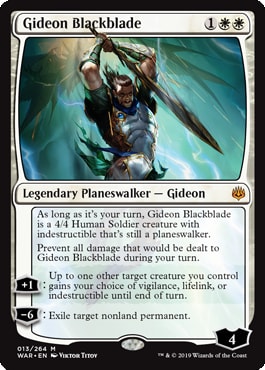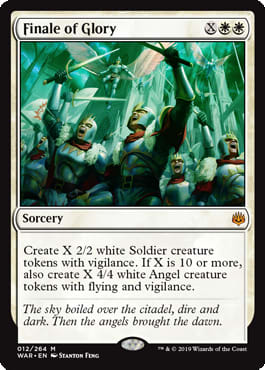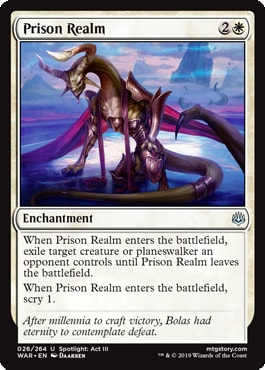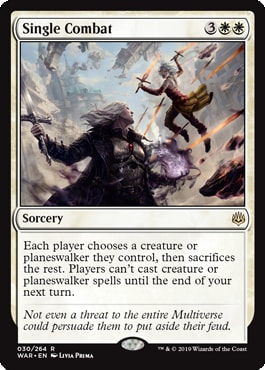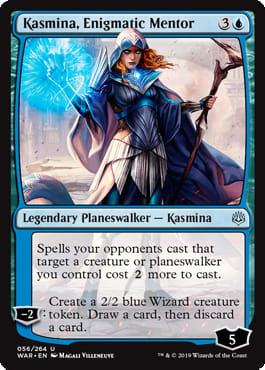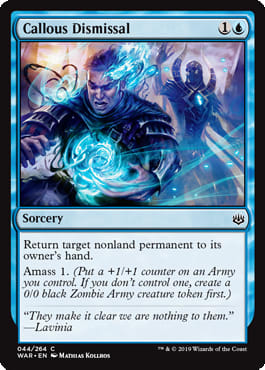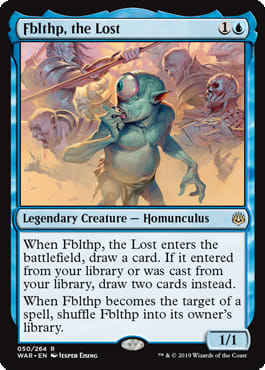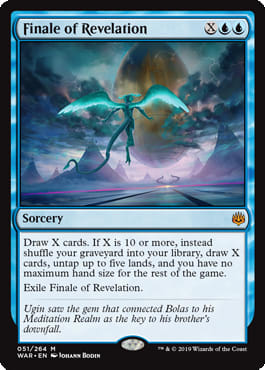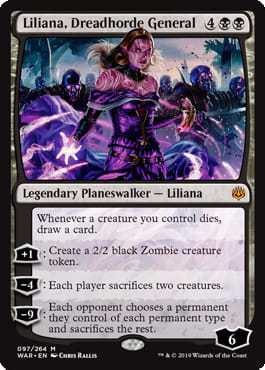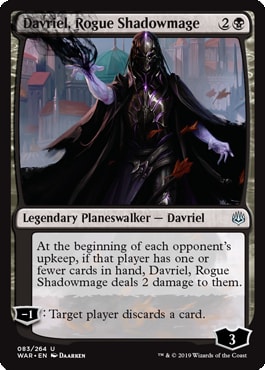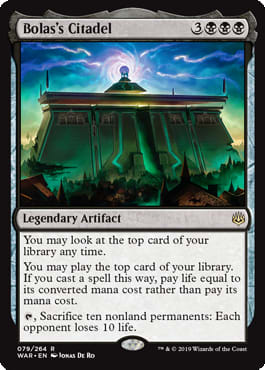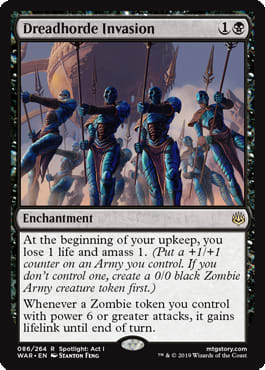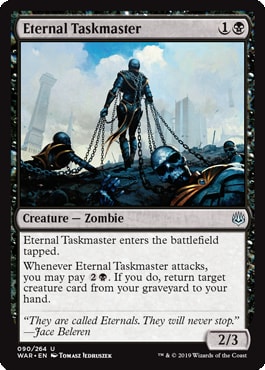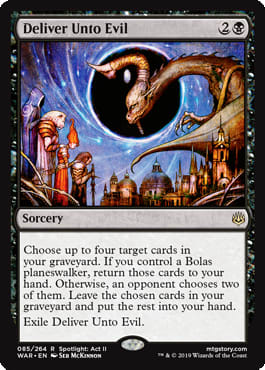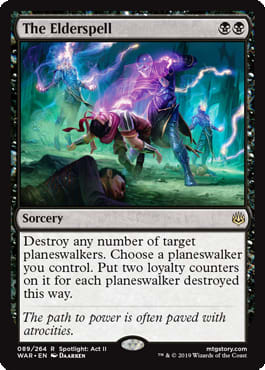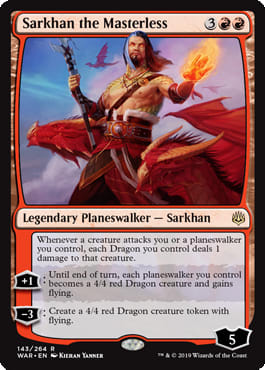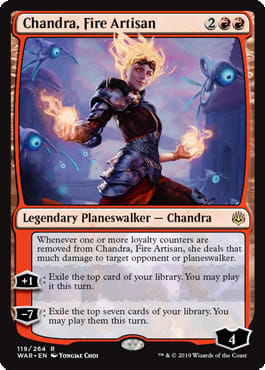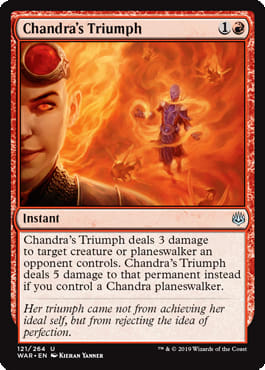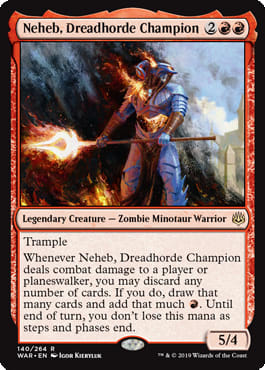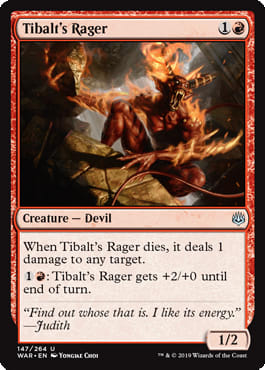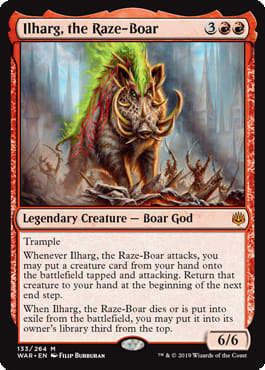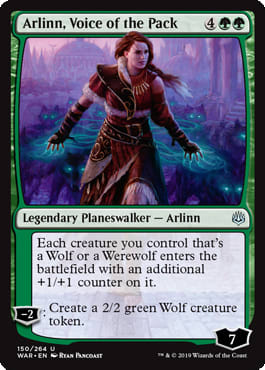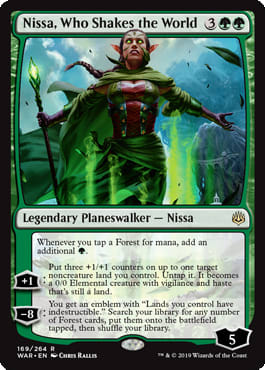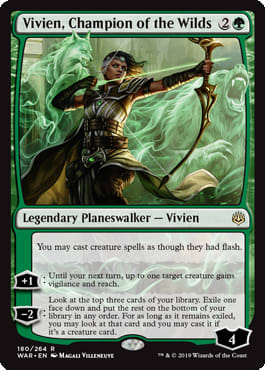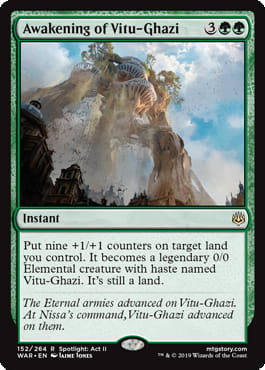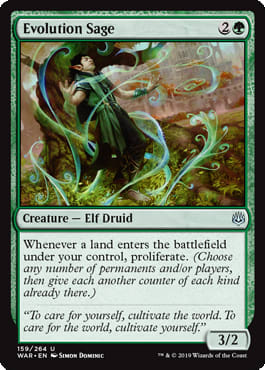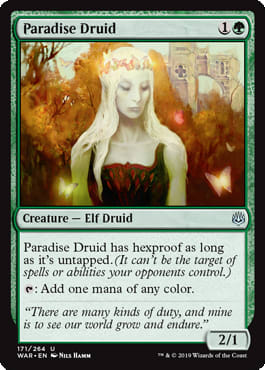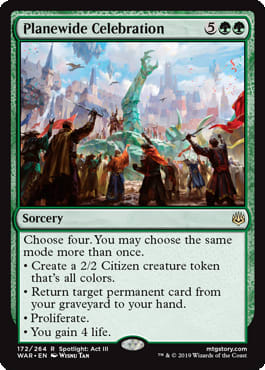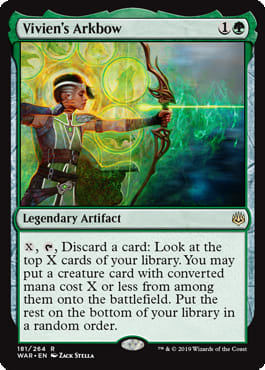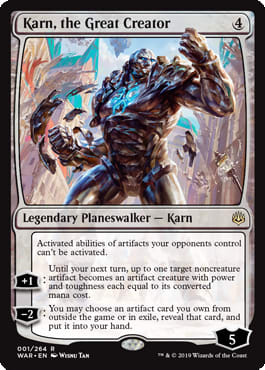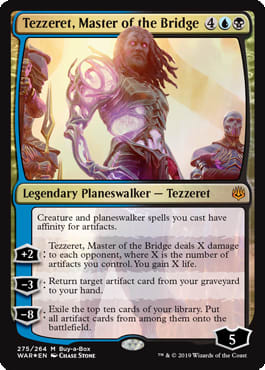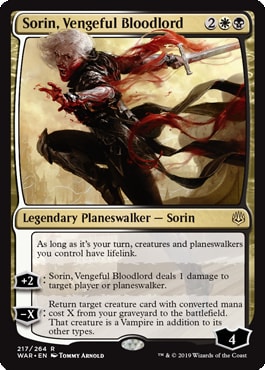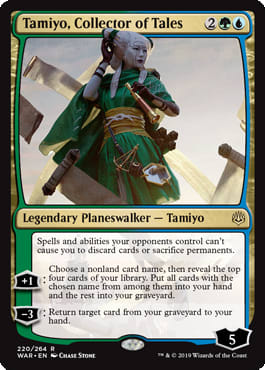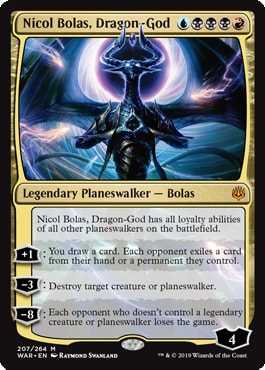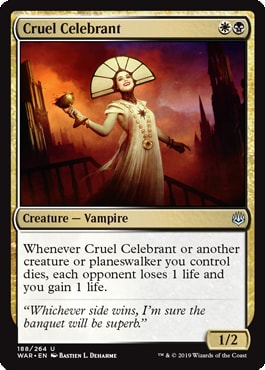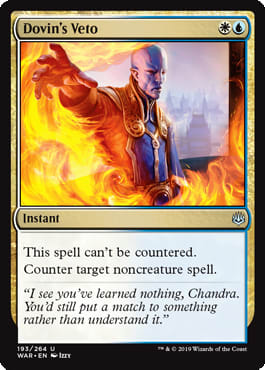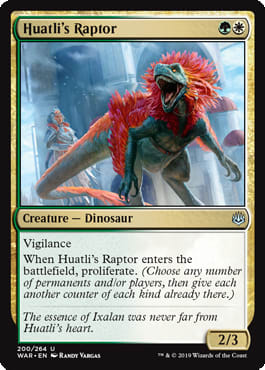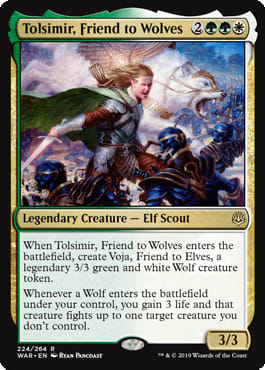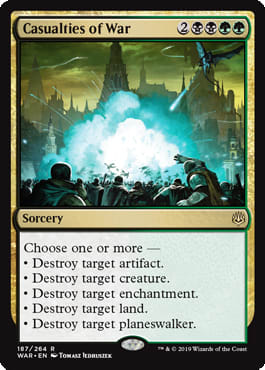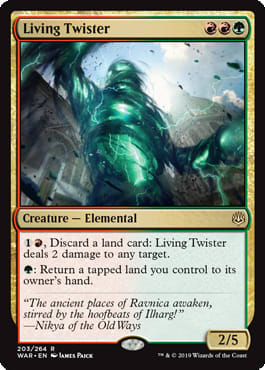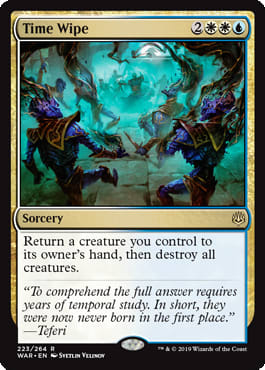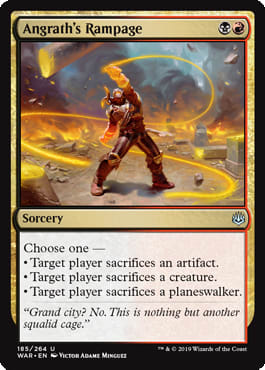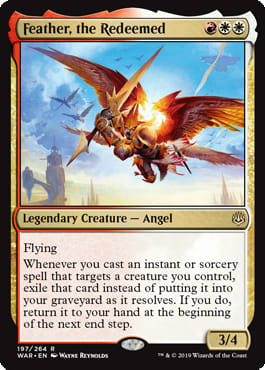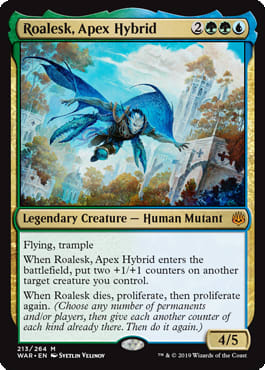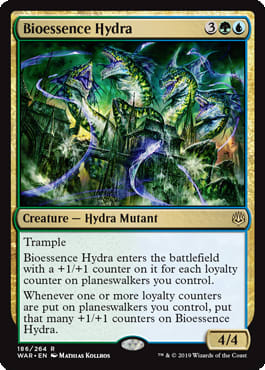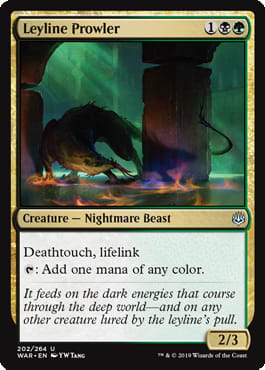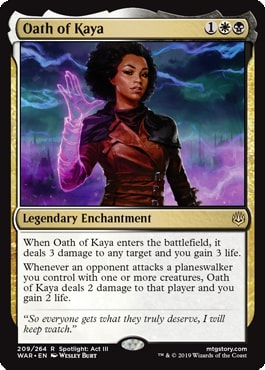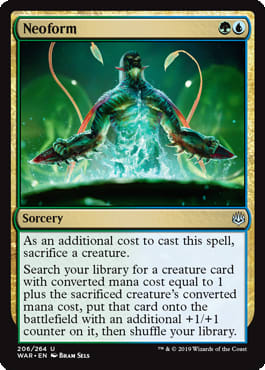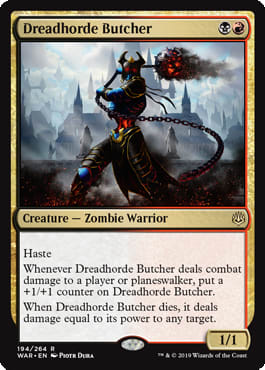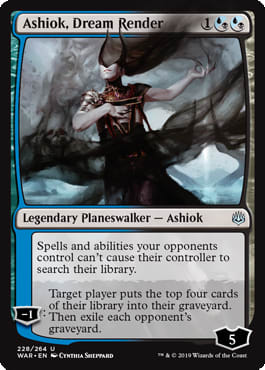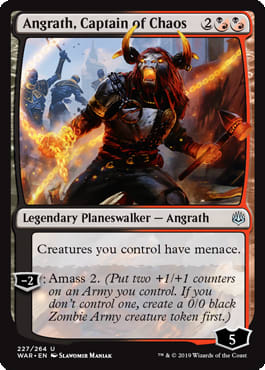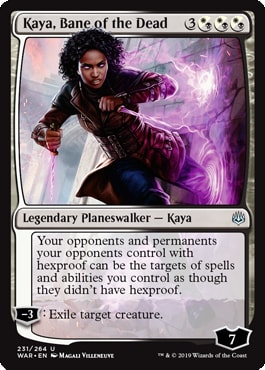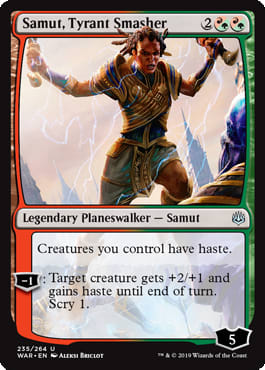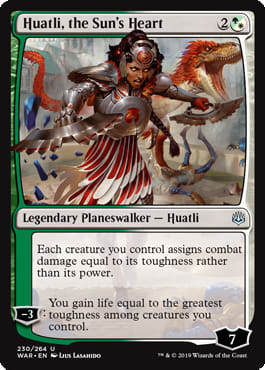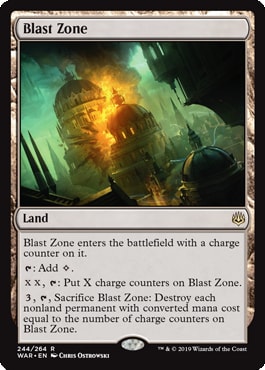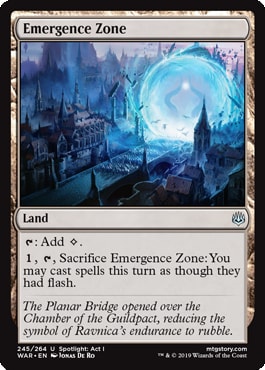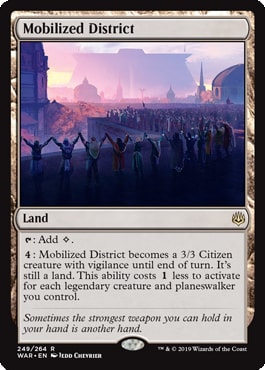In the last two set reviews, I've talked about how the previous blocks had influence by Play Design, with this being the first set with full Play Design focus:
Of note: these evaluations are based on Cube experience (about 6 Cube drafts' worth) in my Cube and not just outsourced to other formats. While my Cube is powered, my experiences should be comparable to yours, provided it does not have unique design restrictions (i.e. Pauper or Peasant).
As I've been doing in recent reviews, I'll be referencing decks that have utilized War of the Spark cards that won/had the best record in Cube drafts. Of course, going 3-0 with a card in a deck isn't ironclad proof of a card being good, but I'll be describing how these cards have performed in winning Cube decks.
Like Guilds of Ravnica and Ravnica Allegiance, this set is also really good for Cube, and like those sets has a lot of good workhorse cards. Guilds of Ravnica had cards like Assassin's Trophy, which is an incredible Golgari card, but also had a lot of solid performers like Risk Factor and Venerated Loxodon, which aren't quite as obvious as Trophy. Ravnica Allegiance continued this trend with cards like Gutterbones, Biogenic Ooze, Light Up the Stage and Tithe Taker to name a few. This is the longest article I've written, as there are a lot of great Cube cards here. Stay a while, and listen.
White
Gideon Blackblade - If you look at Gideon Blackblade as if he were a traditional planeswalker, he looks weak since he can't defend himself and has little immediate board impact, but it's important to realize that this version of Gideon is an indestructible 4/4 first and a planeswalker second. Gideon Blackblade is incredibly one-track even compared to other Cubeworthy Gideons. Because of this, he's best used in aggressive decks like this:
Cube Example Deck #1 | Cube | Usman Jamil
- Creatures (9)
- 1 Adanto Vanguard
- 1 Dauntless Bodyguard
- 1 Figure of Destiny
- 1 Isamaru, Hound of Konda
- 1 Leonin Relic-Warder
- 1 Mardu Woe-Reaper
- 1 Mother of Runes
- 1 Snapcaster Mage
- 1 Thraben Inspector
- Planeswalkers (5)
- 1 Gideon Blackblade
- 1 Gideon of the Trials
- 1 Gideon, Ally of Zendikar
- 1 Serra the Benevolent
- 1 Teferi, Time Raveler
- Instants (2)
- 1 Path to Exile
- 1 Remand
- Sorceries (3)
- 1 Armageddon
- 1 Fractured Identity
- 1 Ravages of War
- Enchantments (2)
- 1 GO TO JAIL
- 1 Legion's Landing
- Artifacts (2)
- 1 Heirloom Blade
- 1 Mana Crypt
- Lands (17)
- 4 Island
- 8 Plains
- 1 Mishra's Factory
- 1 Plateau
- 1 Scalding Tarn
- 1 Strip Mine
- 1 Volcanic Island
Nothing too fancy, a bunch of small White creatures that want to end the game as soon as possible. I found that his +1 was subtly useful for aggro, as all of the modes came up in testing from helping with racing scenarios to chump attacking. Dismissing his +1 as a bad version of Ajani Steadfast's +1 doesn't take into account that he's using the ability in addition to him being an indestructible 4/4, an axis that we don't see in planeswalkers - even other Gideons. All of these parts make Gideon Blackblade an efficiently costed threat for ![]()
![]()
![]() and even his ultimate, while not game-ending, tends to be very impactful when it matters.
and even his ultimate, while not game-ending, tends to be very impactful when it matters.
While White 3-drops have gotten better over the years, don't discount him because he doesn't fit your Standard definition of a planeswalker or aggro beater, but just temper your expectations accordingly and don't discount it because Azorious_3_Creature_Control.dek uses it poorly.
Teyo, the Shieldmage was a card that I found wasn't worth playing as it was unplayable in aggro and better options exist for slower White decks. In peasant, this looks better, but if anything, a lot of Cubes need more aggro cards, not aggro hosers, making Teyo not great for Cubes.
The Wanderer - the best thing about this is that it shares the name of an Emperor song, but does little else. It's essentially a Mark of Asylum for you and your guys with a few Reprisals for value. It's worse than Teyo - don't bother.
Law-Rune Enforcer - one-mana tappers are great underrated Cube cards for creature matchups. I've been trying Gideon's Lawkeeper and Goldmeadow Harrier at the suggestion of friend Sirfunchalot and found them to be impressive in aggro decks -even if they don't attack for 2.
Law-Rune Enforcer has been a workhorse 1-drop as well, like in this deck:
Cube Example Deck #2 | Cube | Usman Jamil
- Creatures (11)
- 1 Brimaz, King of Oreskos
- 1 Cabal Therapist
- 1 Figure of Destiny
- 1 Isamaru, Hound of Konda
- 1 Knight of the Holy Nimbus
- 1 Law-Rune Enforcer
- 1 Monastery Mentor
- 1 Phyrexian Revoker
- 1 Plaguecrafter
- 1 Thalia, Guardian of Thraben
- 1 Tomik, Distinguished Advokist
- Planeswalkers (5)
- 1 Ajani, Adversary of Tyrants
- 1 Elspeth, Knight-Errant
- 1 Elspeth, Sun's Champion
- 1 Liliana, Dreadhorde General
- 1 Serra the Benevolent
- Instants (2)
- 1 Liliana's Triumph
- 1 Secure the Wastes
- Sorceries (1)
- 1 Ravages of War
- Enchantments (3)
- 1 Banishing Light
- 1 Nether Void
- 1 Oblivion Ring
- Artifacts (3)
- 1 Mana Vault
- 1 Mox Jet
- 1 Mox Pearl
- Lands (15)
- 1 Swamp
- 7 Plains
- 1 City of Brass
- 1 Flooded Strand
- 1 Godless Shrine
- 1 Scrubland
- 1 Shambling Vent
- 1 Strip Mine
- 1 Verdant Catacombs
The inability to tap things like tokens, 1-mana creatures like Mother of Runes, mana elves and aggro 1-drops ware not enough to render this card bad, as, when the Law wanted to tap a creature, the Law-Rune Enforcer was able to do it. The ability to tap using a colorless mana was useful to have. Overall, I've liked this one more than its predecessors. If you haven't tried the 1-mana tappers, this is a good introduction.
Tomik, Distinguished Advokist - Tomik is a flying pushed pile of stats, even by modern creature standards, as the only other 2-mana flying White creature with such good stats is Serra Avenger which sees little Cube play since she's more of a 4-drop than a 2-drop. Tomik's preview article furthers this, noting that he was created as primarily a 2/3 flier for ![]()
![]() to attack planeswalkers.
to attack planeswalkers.
As Tom Ross noted in his Tomik article, Tomik also prevents the opponent from interacting with their own lands, so they can't equip creature lands or put beneficial auras on them like Utopia Sprawl. Again, in Cube, it's a small effect but it's gravy on top of an already good White aggro creature. When I tried Tomik out, his land ability didn't come up incredibly often, but it's nice to have in decks with creature lands which are common inclusions in the same kind of decks that Tomik flourishes in. Hexproof is, after all, a stupid ability.
Ultimately, Tomik joins a motley cast of solid White 2 CMC role players like Adanto Vanguard, Knight of the Holy Nimbus, Wall of Omens, and so on. He certainly isn't an S-tier card like Stoneforge Mystic, but he'll make your Cube more often than not, especially if you're wanting to make sure White aggro is a consistent and powerful strategy.
Finale of Glory - If this is your first time here, I frequently talk about flexible cards needing to have what I call a good "base rate" while doing something a Cube deck generally wants to do (Burst Lightning and Shriekmaw, for example).
Indulge me while I soapbox about card evaluation.
It's a tale as old as time to discount X spells because they look weak at low rates. In particular, the X-burn spells like Fireball and Comet Storm may be first-pickable to straight up busted in retail Limited, but these cards are ultimately too mana-inefficient to see Cube play. As such, their flexibility to underrate, as we saw with Sphinx's Revelation, which doesn't outpace Limited fodder like Jace's Ingenuity until x=3. When thinking purely on the basis of mana efficiency, a Sphinx's Revelation for 1 or 2 looks terrible - that being said, sometimes firing off a tiny Revelation is the right thing to do to make land drops. Having this option on top of just outcarding your opponent late-game is what distinguishes Revelation in particular from other X-spells.
Conversely, arguments like "I'll never get to a gazillion mana, so I'm not putting in a 'bad' ![]()
![]()
![]()
![]() card in my Cube" are overly reductionist. These kinds of scenarios do happen (what, you've never flooded on lands before in your life?) and decks do end up in areas outside of their comfort zones, since, as philosopher Mike Tyson put it, "Everyone has a plan until they get punched in the face."
card in my Cube" are overly reductionist. These kinds of scenarios do happen (what, you've never flooded on lands before in your life?) and decks do end up in areas outside of their comfort zones, since, as philosopher Mike Tyson put it, "Everyone has a plan until they get punched in the face."
One of the things I like most about cards like Firedrinker Satyr is that although we tend to think of games happening with us perfectly hitting our mana curves and crushing our opponents underneath our heels triumphantly by turn four, just in time for afternoon tea. The reality is that this just doesn't always happen. The Satyr might suck when compared on stats to premier 1-drops like Zurgo Bellstriker and Goblin Guide, but its ability provides an outlet for unused mana later in the game, if it gets that far. In short, mana sinks can be great in the late game.
So what exactly is Finale of Glory? Is it a Blaze, or is it a Revelation? It's important to note that the sweet spot for Finale of Glory is X = 3. Up until this point, it's worse than draft chaff, much like how Hydroid Krasis doesn't really start paying off until X = 4. As mentioned before, flexibility does matter, but for the purposes of argument, let's consider the base rate on Finale of Glory to be X = 3, making it a ![]()
![]()
![]() card.
card.
My testing impression is that Finale of Glory is essentially a spin on Secure the Wastes that trades the flexibility of being an instant with stronger ooph on rate and better tokens. 1/1 tokens are about as bog standard as they come, but 2/2 vigilance soldiers really only get punished in a tempo-negative fashion for you with Pyroclasm-like effects, which are very rare, and having vigilance is great in a racing situation.
A deck that may want Secure the Wastes may not immediately gravitate toward Finale of Glory as they play differently - decks with Secure want it as a flash threat to run out while holding up countermagic, for example, while a Finale of Glory deck just wants to bust chops with 6 vigilant power for five mana or more. Finale of Glory's latter text is mostly trinket text; casting it for X = 10 never happened in testing and likely will only happen infrequently in the decks it'll typically slot in is a pipe dream, unless your Cube is mono-durdle mirror matchups.
In any case, I've liked the card so far when trying it out. White 5-drops are mostly angels that have a weakness to spot removal and this helps to diversify that weakness, being a generally good go-wide threat at ![]()
![]()
![]() that can scale higher if need be. At the end of the article, there's a 3-0 mostly White aggro deck that had Finale of Glory and while, in theory, it wanted to just cast it for 3, there were times when it got cast for more mana because the game just happened to get to that stage.
that can scale higher if need be. At the end of the article, there's a 3-0 mostly White aggro deck that had Finale of Glory and while, in theory, it wanted to just cast it for 3, there were times when it got cast for more mana because the game just happened to get to that stage.
Prison Realm initially seemed bad, as my initial impression of Prison Realm was that it was like Stasis Snare - a bad version of B-team White removal like Journey to Nowhere or Declaration in Stone, until my friend SirFunchalot had it in his list of cards to try out. They pointed out that it's closer to Ruinous Path and Never // Return than Stasis Snare, where you're trading an immediate scry 1 and easier mana cost for potential late game use. Is it better than these latter two? Honestly, it's about a wash, with a slight nod to Prison Realm.
While scry 1 can't turn a bad card into a good one, it generally is enough to turn something that's on the fence into something playable, like Dissolve, much like how the ability to hit planeswalkers can make an unplayable card (Murder) into a Cube all-star (Hero's Downfall). Because of that, it's been performing decently.
God-Eternal Oketra is a prime example of a "Baneslayer" style creature. Years ago, Patrick Chapin defined Baneslayers and Mulldrifters as follows:
Baneslayers are creatures where the value is in the creature itself. Mulldrifters are creatures that give you value outside of the creature.
Baneslayers:
Lotus Cobra, Hero of Bladehold, Birds of Paradise, Consecrated Sphinx, Kor Firewalker
Entomber Exarch,Wall of Omens, Sea Gate Oracle, Manic Vandal, Stoneforge Mystic
There are a few creatures that are truly both which are quite rare and are normally identifiable by the word "Titan" appearing on the card. Emeria Angel, Cunning Sparkmage, Oracle of Mul Daya and Ulamog are examples. A good rule of thumb is: "If you care about killing it it's a Baneslayer."
If killing it loses value it tends to be a Mulldrifter. Drawing extra cards has nothing to do with being a Mulldrifter as Consecrated Sphinx, Dark Confidant and Scroll Thief are all Baneslayers. Card advantage is not a must for a card to be a Mulldrifter. If you're playing an aggressive deck, most creatures with haste can end up being Mulldrifters since you can often get at least one hit in before it dies. Understanding the difference between Baneslayers and Mulldrifters is a crucial element of high-level deck-building.
Oketra's got a fairly mediocre body as far as White 5-drops go - you're playing her for her ability, which doesn't trigger unless you cast a creature, and usually this requires that she survives until your next turn. While I found this wasn't hard to accomplish in White midrange decks, and getting a 4/4 or two out of Oketra wasn't uncommon, the same problem I mentioned about White five-cost cards still exists. There are too many darned Angels, and Oketra is really just a Baneslayer with groupies. The removal resistance ability for Oketra (and the rest of the gods), was, I found, generally too slow to be relevant in the majority of the games. Ultimately, in my opinion, Oketra's fine, but she's not going to crack into small or medium Cubes.
Topple the Statue is artifact hate that can cycle itself but at the cost of 3 mana, even though it can tap something to cycle, it's at a mana cost that's too high as many Cubes don't need something that's worse than, say, Forsake the Worldly.
Single Combat - Cards like Harsh Mercy and Divine Reckoning generally aren't good because the opponent will just choose to save the best thing that they control, and generally that one thing is the thing you wanted to kill in the first place. Decks that want wrath effects want to kill everything because they want to reach the late game and typically don't play many creatures of their own. Also, there are like four good 4 CMC Wrath variants; to see play in Cube, a 5 CMC wrath has to be extremely good to cut the mustard at this higher cost, and this doesn't get there.
Blue
Jace, Wielder of Mysteries is worth discussing for one fact: he's one of only two 4-mana planeswalkers with an ability that simultaneously adds loyalty and draws cards, with the other being Karn, Scion of Urza. That is unfortunately the only thing worth saying though, since unlike Karn, he has a prohibitive ![]()
![]()
![]()
![]() mana cost, meaning only Mono-Blue or decks with strong mana can support him. And he can't defend himself. Contrast that with cards like Coercive Portal, which sits there and draws you cards and isn't afraid of anything. Except artifact hate. Overall though, I've found it isn't that hard to defend him since his starting loyalty of five is respectable. His milling generally wasn't relevant, and the Laboratory Maniac self-mill win did come up at least once, but for the most part, he's basically a Coercive Portal with some extra play to him that few decks can reliably play, and that's about it. As a Blue-specific 4 CMC card advantage engine, he's rather undistinguished, but if you have the space for him, he'll do fine.
mana cost, meaning only Mono-Blue or decks with strong mana can support him. And he can't defend himself. Contrast that with cards like Coercive Portal, which sits there and draws you cards and isn't afraid of anything. Except artifact hate. Overall though, I've found it isn't that hard to defend him since his starting loyalty of five is respectable. His milling generally wasn't relevant, and the Laboratory Maniac self-mill win did come up at least once, but for the most part, he's basically a Coercive Portal with some extra play to him that few decks can reliably play, and that's about it. As a Blue-specific 4 CMC card advantage engine, he's rather undistinguished, but if you have the space for him, he'll do fine.
Kasmina, Enigmatic Mentor has a good static ability that works similarly to that of Kira, Great Glass-Spinner to protect your own creatures. I found that she's also a pretty decent pile of value with her making two 2/2s that loot when they enter the battlefield, which gum up the board well. However, with Jace, Wielder of Mysteries and God-Eternal Kefnet in this set, she has a hard time competing with other options in normal Cubes, but she's excellent for Peasant.
Narset, Parter of Veils has a highly situational static and her ability is reminiscent of Search for Azcanta. While one might want to compare her to Jace Beleren as another ![]()
![]()
![]() planeswalker that sits on the board to draw cards, the comparison is not entirely apt. I've talked before about how abilities with restrictions on possible hits like Augur of Bolas tend to be harder to utilize in Cube, because Cube decks tend to be more difficult to construct with proper card type ratios in mind to maximize the odds of drawing while not making suboptimal draft picks for your deck. This deck was able to utilize her, and had nearly half of the deck count as hits:
planeswalker that sits on the board to draw cards, the comparison is not entirely apt. I've talked before about how abilities with restrictions on possible hits like Augur of Bolas tend to be harder to utilize in Cube, because Cube decks tend to be more difficult to construct with proper card type ratios in mind to maximize the odds of drawing while not making suboptimal draft picks for your deck. This deck was able to utilize her, and had nearly half of the deck count as hits:
Cube Example Deck #3 | Cube | Usman Jamil
- Creatures (3)
- 1 Bioessence Hydra
- 1 Myr Battlesphere
- 1 Sundering Titan
- Planeswalkers (8)
- 1 Jace, Wielder of Mysteries
- 1 Karn Liberated
- 1 Karn, Scion of Urza
- 1 Karn, the Great Creator
- 1 Kiora, Behemoth Beckoner
- 1 Narset, Parter of Veils
- 1 Nissa, Who Shakes the World
- 1 Tezzeret, Master of the Bridge
- Instants (2)
- 1 Mana Drain
- 1 Mana Leak
- Sorceries (2)
- 1 Contentious Plan
- 1 Tinker
- Enchantments (1)
- 1 Opposition
- Artifacts (7)
- 1 Black Lotus
- 1 Gruul Signet
- 1 Mox Opal
- 1 Retrofitter Foundry
- 1 Simic Signet
- 1 Tangle Wire
- 1 Winter Orb
- Lands (16)
- 3 Swamp
- 6 Forest
- 6 Island
- 1 Tree of Tales
As cliche as it may sound, she's better in decks that can utilize her well as two Azcanta activations are generally decent value, but things like Oath of Jace and Thirst for Knowledge ultimately do a better job at providing cheap card advantage/filtering for control. It's worth noting that she can't refill her loyalty without a lot of work, so while she has a theoretically higher ceiling, it's not easy to reach and may as well not factor in your assessment of Narset. She appeared in a few 3-0 decks and, as noted at the top, that isn't ironclad proof of her being a good card, but overall feedback had players impressed by her minus ability.
Callous Dismissal is the cheapest and most pushed Man-o'-War effect ever printed, as it's essentially a ![]()
![]() 1/1 that bounces a non-land permanent instead of creature. Man-o'-War types of cards have historically been great in Cubes as they slow down the opponent and leave you with a relevant body, providing positive tempo, since the mana invested by your opponent almost always exceeds the
1/1 that bounces a non-land permanent instead of creature. Man-o'-War types of cards have historically been great in Cubes as they slow down the opponent and leave you with a relevant body, providing positive tempo, since the mana invested by your opponent almost always exceeds the ![]()
![]() you spent.
you spent.
Amass cards are currently very underrated due to fear of diminishing returns and fear of throwing more eggs into a single basket when all you want is another creature. However, in my testing, even with the artificially increased density of amass cards due to my aggressive testing of new cards, the drawback of wanting to have a card with amass boost a creature when you just want a body has hardly come up, with the situation occurring only in a few corner cases with cards that amassed multiple times, like Angrath, Captain of Chaos and Dreadhorde Invasion.
When compared to instant versions like Into the Roil, Blink of an Eye and Cyclonic Rift, this ends up being better as having the effect on a body allows it to be cast on curve is actually reasonable (casting an Into the Roil on your opponent's turn two play generally feels awful and is usually wrong) as the 1/1, as dinky as it is, provides a warm body to augment your board presence. After all, cards like Phyrexian Revoker see a lot more Cube play than Pithing Needle, as having the disruptive effect on a creature makes the card significantly less narrow and actually maindeckable. As tempting as it may be to dismiss this as yet another bounce effect because it isn't an instant, this is a better version of them and worth a round in your Cube.
Crush Dissent - The card is essentially a more general Summoner's Bane, trading Remove Soul for Quench. Remove Soul effects generally have a hard time outside of pauper Cube, especially in decks like Dimir that have creature removal anyway. This is one of the more underrated cards of the set, possibly from underestimating amass and outsourcing evaluation to LSV's WAR Limited review. Why bother? Consider this as riff on Mystic Snake, a multicolored card that has seen extensive Cube play, that trades a much easier mana cost for more Limited timing windows. Contrary to fears, it wasn't hard to counter something since Cube games generally rely on using mana efficiently.
Even countering a ham sandwich in the early-to-mid game is fine since you're almost always getting ahead on mana expenditure, and the 2/2 provided is a relevant clock. This card, like Snapcaster Mage, is a legitimately strong card in situations like control mirrors, in which getting a threat on board forces the opponent into unfavorable interactions on your own terms. While it can't be cast without a target, I found this hardly mattered. That being said, we've got several good 4's in this set and blue isn't exactly hurting for more tempo cards, but this is a decent one and if you have a Cube with rarity restrictions, this should definitely be in your Cube.
Commence the Endgame is yet another Blue finisher that's comparable to Torrential Gearhulk as a powerful instant speed card advantage card stapled to a threat. The absolute floor is a 2/2, but in practice the Amass token was almost always between a 4/4 to a 6/6. As a result, it doesn't immediately lose to Gearhulk, which has a higher floor on stats, being a 5/6 regardless of the situation, but the two cards drawn plus the Amass token, which is generally a respectable size, gives you an effective floor of 3 cards to Gearhulk's two (flashbacked instant plus Gearhulk itself).
In the Ravnica Allegiance review, I talked about how Blue generally doesn't need more big-mana plays and big expensive finishers, but this card does both, and that's worth considering. There is a comparison that could be made between this and Mulldrifter as another draw spell stapled to a body, but the cards functionally serve different purposes, with Mulldrifter having a Divination base mode with the ability to kick it for a 2/2 flier if need be, and Commence the Endgame being, primarily, a flash threat that draws a card and was almost always large enough to bust an opponent's chops with.
My friend SirFunchalot had similar experiences with it being good, noting that:
I'm pretty sure it's just better Consecrated Sphinx
when your Consecrated Sphinx eats a Doom Blade or a Mana Leak it feels real rough
this thing is like at worst a 3 for 1, usually a 4 for 1
6 mana 5/5 flash etb draw 2 can't be countered is absurd
one game it came in as an 8/8 and blocked a carnage tyrant
such an obscene blow out"
If your conclusion from pointing out negatives on Consecrated Sphinx is thinking that this is better than Consecrated Sphinx, think again; Consecrated Sphinx has an absurd amount of value if it doesn't die to a Doom Blade, but its weakness to instant speed removal is hardly a small thing, since if you're the control deck, your opponent likely has been waiting for something to aim a Doom Blade at.
As a big flash threat, I was a fan of Dream Eater as it had value outside of its body 4/3 body, and I found that Commence the Endgame is significantly better at the role of big blue finisher. As Blue doesn't need a lot of good finishers and they come a dime a dozen, they really need to be good to make it into Cube; Commence the Endgame punches well within its weight class as one of the best 6-mana Blue finishers in Cube.
Lazotep Plating - In theory, Lazotep Plating is a Negate with the additional ability to counter abilities like Wasteland, but I often saw this card in practice hamstrung in hand or cashed in for a warm body. I really wanted to like this, but it was a poor performer.
Fblthp, the Lost - I've talked often about Additive Distraction and how it's a common misevaluation trope, impacting cards from Sphinx of Jwar Isle to History of Benalia. If you're new to these reviews, control+F additive distraction in this Mark Rosewater article.
Fblthp being a meme and having some weird text that functionally doesn't matter short of Proteus Staff combos in EDH likely impacts evaluation even if it happens on a more subconscious level, although it looks like people overall are starting to realize he's basically a Blue Elvish Visionary - and that's fine.
It seems like an odd talking point for the card since Cubes don't generally run Elvish Visionary and comparing a card to a card that many people don't Cube is generally a talking point against cards, but color identity matters here. Consider Harmonize, which is basically Concentrate, and Sunlance, which is Strafe - a card that no one's heard of, for good reason. Consider how much more often these cards see play compared to their normally colored counterparts (if your argument is that you're not playing either, you're missing the point); Harmonize's and Sunlance's effects are more useful in their respective colors than Concentrate and Strafe, cards that are a dime a dozen in their respective colors.
So why care about Fblthp? It's a cheap cantripping creature in a color that rarely sees these kinds of cards. Most Blue decks generally want to stymie life loss and gain card advantage for the later stages of the game, and Fblthp is a decent roleplayer in that respect that synergizes with blink effects.
His second ability hardly matters - most spells that would target him would kill him anyway, so it functionally becomes a riff on Norin the Wary. There are corner case benefits to having a shuffle on command, I suppose. My main concern with him in testing was that he's a 2 mana card and blue decks generally have things to do on 2 mana - mana rocks and counterspells. Still, this helps for scenarios when you just need a roadblock or something to pick up equipment and is hardly just a meme card, and is better than you think.
Kasmina's Transmutation - This mainly gets consideration because of its color identity, as Blue lacks efficient hard removal. Don't bother with this card in your Cube - even in Pauper, you have Curse of Chains and Narcolepsy which are generally better.
Narset's Reversal - Only getting instants and sorceries makes this more of a Muddle the Mixture than a Remand. Due to the limited number of targets, this is just too narrow.
Finale of Revelation - See Finale of Glory for my prior discussion on X spells.
This is an improved Mind Spring, with the caveat of being unable to double as a win condition like Braingeyser or Stroke of Genius. Being a sorcery is a massive turn off, as these X draw spells typically derive playability either from being instant speed, like Stroke of Genius and Pull from Tomorrow, or from an efficient rate on mana. Unfortunately, it's atrocious on rate and unlike Sphinx's Revelation, never reaches a point where it's good. A deck like combo could potentially utilize this to draw a ton of cards and then get a pseudo-emblem but overall, it's just not worth inclusion.
God-Eternal, Kefnet - When Kefnet was previewed, theCubemiser noted how Kefnet outmuscles almost everything at four mana on a pure power and toughness basis and looking at the Cubetutor 450-card average, only Polukranos, World Eater, Hero of Bladehold and Gideon, Ally of Zendikar (if the latter two count) come close to raw stats for a 4-mana creature.
When I tested Curator of Mysteries and Sphinx of Foresight, I found that their 4/4 flying bodies were surprisingly relevant in their respective decks and emulates those with a slightly better body.
Generally, I found that Kefnet's miracle ability triggered only about once or twice in a game without assistance, and I'm sure this matches up with what people will math out. As a result, I would evaluate Kefnet as a Baneslayer more than anything else. Of course, if you had top deck manipulation, especially repeatable library manipulation like Sensei's Divining Top and Scroll Rack, go hog wild on the gravy train, but don't treat Kefnet like it's a card advantage engine in the same way one thinks of the Jaces.
Initially, I had thought that this card was absurd, especially on a pure stats basis, but ultimately Kefnet is just one slightly fatter Blue dude in a sea of other 4 CMC big Blue fliers, and his miracle ability is just gravy in practice, making this big Blue bird not particularly unique as far as effects go.
Contentious Plan - Generally, proliferate isn't worth the mana tax, since it can be hard to assemble the combo of proliferator + planeswalker. Because of this, while it's a cantrip, it's at a very poor mana rate for Cube and is a sorcery and proliferate just isn't enough to save it from mediocrity.
Spark Double is an obvious comparison to Clever Impersonator as a four mana Clone with greater versatility and a slight bonus for copying planeswalkers, but even then it doesn't do the most important thing that Clever Impersonator does - copy opposing big boom booms and bring board parity. As a result, it's the very definition of a rich-get-richer card, and is not worth consideration.
Black
Liliana, Deathhorde General - while her +1 to make a 2/2 looks weak, her static ability makes them excellent chump blockers, and card advantage overrun your opponent, even if checked. Obviously, decks going deep on sacrifice shenanigans love this Liliana, but again, because she produces her own fodder, you don't need to build around her.
Her minus ability is Barter in Blood, which is another restrictive pseudo-wrath effect much like Elspeth, Sun's Champion's Retribution of the Meek ability. It's reasonable for board control. Of course, it's overcosted if that's all you're looking to do, but obviously Liliana is not just a six mana Barter in Blood.
So how does Liliana perform? Exceptionally well, though part of it is secondary to lack of competition. Black six CMC finishers consist of two groups:
- Grave Titan
- Everything else
Grave Titan is just so far above the curve compared to even other obnoxious Limited bombs like Noxious Gearhulk, Massacre Wurm, and Demonlord Belzenlok, that these effectively act as filler. Liliana feels more like a Grave Titan than anything else that has come before her, as she's a must-answer threat that stabilizes the board immediately and rapidly drowns the opponent in card advantage. The only downside I've really found for her so far is that she can't be reanimated, but that does not remotely detract from her absurd power.
Davriel, Rogue Shadowmage - I found that Davriel either played as a Mind Rot (that takes 2 turns) combined with The Rack or as a discounted slow-release Fugue.
Slow-release discard is much worse than regular discard, not just because of the delay in card advantage accrual, but because the opponent has the opportunity to play around it and brace for impact. If the opponent's hand isn't under duress, it may as well be a blank. As a result, I found in my testing that even aggressive decks, which generally might appreciate a decently costed disruptive element plus damage source, typically weren't including Davriel in their final 40. I also found Davriel to be too low-impact in slower, more midrange Black decks, though it did see sideboard play in situations where cashing in Davriel for three of your opponent's cards was a big game.
Ob Nixilis, the Hate-Twisted - This version of Ob Nixilis effectively gives you two castings of Oblation for creatures, while punishing your opponent for drawing cards, even off of Ob Nixils. That being said, Ob Nixilis, the Hate-Twisted is worse than the other Ob Nixilis planeswalkers for Cube because he's just so slow. Even at peasant, I don't think he's going to do that much, what with the plethora of good 187 creatures in the format like Nekrataal, Shriekmaw and Skinrender to provide more immediate value.
Liliana's Triumph is a Diabolic Edict with a few (mostly irrelevant) upsides. It isn't strictly better as there are corner cases where you'd want to sacrifice your own things but they're extremely rare. Speaking of rare scenarios: Liliana's Triumph did not often have the active Liliana planeswalker bonus in testing, but that's mostly irrelevant as the card is first and foremost a reskinned Diabolic Edict, which is still a solid removal spell unless your Cube is designed to generate absurd walls-of-creatures board states. While it is an upgrade to Diabolic Edict, there's likely something worse than Diabolic Edict in your Cube. Do the work and find out what it is and cut that instead.
Banehound suffers from the problem of not having enough stats to be relevant for aggro. It's similar to Healer's Hawk in that it holds pants well with lifelink, but like the Hawk, it's not worth a card without something augmenting its power.
Bleeding Edge was one of the last previews for the set and functions as a riff on Fire Imp. It's been a while since we've seen Fire Imp get a lot of Cube play, and the recent additions of the various Rabblemasters likely haven't helped. Black doesn't tend to get a lot of small removal effects with them being centered around things like Terrors and Edicts, making this is one of the smallest removal spells on a (virtual) creature with an enter the battlefield trigger. If your Cube is in the market for another Nekrataal type of effect, this performs similarly to what you'd expect.
Bolas's Citadel - Frank Karsten did some math on how many cards that Bolas's Citadel can draw here - https://www.channelfireball.com/articles/bolass-citadel-is-a-new-powerhouse-combo-engine/.
While the math shown is regarding Experimental Frenzy in particular, it is extrapolatable since they're doing similar things and have the same bottleneck of getting shut down by two lands off the top of the deck. Of course, hitting ![]()
![]() is significantly easier in an aggro deck or a deck that mostly utilizes cheap cards than it is for that kind of deck to hit, or even include, a card that costs
is significantly easier in an aggro deck or a deck that mostly utilizes cheap cards than it is for that kind of deck to hit, or even include, a card that costs ![]()
![]()
![]()
![]() .
.
I found that Bolas's Citadel does in fact feel as good as it looks, but the life cost of going off is relevant. Obviously, the faster your opponent's deck is, the less cards you can safely reap from the Citadel. Ultimately, the card, while undeniably powerful, just didn't seem to have a home. The life loss was awkward for decks that were happy to go up to six mana for a card advantage engine. Aggro decks were happy to make use of the Citadel's sac ability for reach, which control decks essentially treated as flavor text, and could easily convert life into cards but were not remotely happy to reach the ![]()
![]()
![]()
![]() necessary to cast it in the first place. It was overall just too taxing on resources for every deck that was interested in it, and the various attributes of the card clashed too much to make it a Cubeable card.
necessary to cast it in the first place. It was overall just too taxing on resources for every deck that was interested in it, and the various attributes of the card clashed too much to make it a Cubeable card.
Eternal-God Bontu overperformed. When looking at a card like Bontu, it's tempting to look at it as a card that's just for Aristocrats-style decks since it's got a sacrifice ability, but found that Bontu wasn't so narrow as either a top end for aggressive decks with its aggressively costed body and ability to trade in irrelevant permanents for more gas, or even as just a value card strapped to a big body. It wasn't uncommon for a player to drop Bontu, sacrifice two outmatched creatures and some extra lands, and suddenly go for match point with a refueled hand and a ? menacer.
Is this card a Mulldrifter in the literal sense? Generally I found that you can't just slam this on turn five and have three random things lying around, but even by then there's a 2/2 that has done its job and is fine to trade in and in the late game, this ceiling gets higher. Of course, Black also features recursive threats like Bloodghast which synergize well with Bontu.
Black 5-drops aren't exactly amazing, but this is a good one. Don't count out this croc.
Command the Dreadhorde - fares poorly as a one-sided Living Death since it requires about 10 life to be worth using. I found that even with creatures and planeswalkers that punch well above their weight class, it wasn't worth it for Cube.
Dreadhorde Invasion - as Mike Sigrist noted, this isn't Bitterblossom, nor is it Fretwork Colony, and as cards tend to not work with our idealized notions, being grounded in the reality that things don't fall isn't the worst case or the best case. Where does it fall in that scope?
I found that Dreadhorde Invasion had 2 modes:
- A defender generator making 1/1s for 1 life, acting like a Forcefield. I guess in this way, it is like Bitterblossom.
- A threat that slowly got larger but then reset itself if it died.
While being able to continually generate zombie army tokens is something that Dreadhorde Invasion could do, it didn't see play in the "sacrifice deck" as it was mainly played as either an aggro threat or a value engine. The text for giving a 6+ power zombie token was mostly irrelevant, unsurprisingly. It's best against decks that are reliant on 1-for-1 removal to grind them out of resources and while it takes some time for a new Zombie Army to start snowballing, not having to wait a turn like you do with Bitterblossom is nice for those decks.
It's closer to Bitterblossom if you absolutely have to make that comparison, but it's more just a generally good value engine and a 2-drop and while it's no Dark Confidant, it's pretty good for a cheap Black engine card.
Eternal Taskmaster has a 3rd toughness that helps attack through 2/2s with a decent ability that's reminiscent of Isareth, but one that works better with recursive creatures. Having your recurred creatures return to hand makes this effect much less powerful than that of cards like Alesha, who Smiles at Death, but it was fine as something to do in the late game. Midrange and control decks aren't in the market for a two mana ? that can't block when it enters the battlefield, so this card functionally served as filler in Black aggro decks.
Finale of Eternity played out more as an anti-aggro small wrath than something like a Languish or Yahenni's Expertise. It can play like a small Plague Wind but I found it was mainly sideboard fodder for bringing it in against aggro and if you're utilizing a slot for a non-Damnation wrath, there are better options than this for your Cube.
Lazotep Reaver is the best Krenko's Command ever, though that isn't saying a whole lot since these token generators have typically sat on the edge of Cube playability due to lack of board presence; cards like Marsh Flitter maybe saw slight Cube play when Pox was in vogue years ago. This only has two power as well, but having an extra point of toughness makes a world of difference from a defensive perspective, as you can profitably block 2/2s and opposing tokens. That being said, it's still filler.
Deliver Unto Evil is an odd take on Yawgmoth's Will, but I found that it required too much setup to be worth playing - requiring either a lot of cards or 4 similar cards in the grave - to make Deliver Unto Evil a Sophie's Choice but even then, it's not worth it.
The Elderspell fares poorly as things like Vampire Hexmage, Hero's Downfall, and Vraska's Contempt are better as they aren't stone blanks if the opponent doesn't have a planeswalker. If you've got a planeswalker problem in your Cube, don't run this card. Just adjust your Cube.
Massacre Girl was a card that was too variable in her board impact. I found she was mostly good against aggressive decks and green decks utilizing mana elves, but pretty mediocre otherwise. Her 4/4 menacing body isn't commonly seen but found that the overall package that she provided just didn't do enough in the overall scope of Cube matches.
Red
Tibalt, Rakish Instigator is better than his initial iteration but he still remains a red-headed stepchild when compared to other three-mana cards. He is mildly unique in that his devil tokens are able to trade with two toughness creatures, but he still doesn't have quite enough board impact to compete with the Rabblemasters or other premier threats like Chandra's Phoenix. His static ability is also hardly relevant - most cards in Cube don't feature life gain.
Sarkhan the Masterless is practically a Broodmate Dragon for ![]()
![]()
![]() as Sarkhan and his companion dragon swings for 8 in the air, though he is significantly poorer on defense relative to the OG. His static ability is fairly unremarkable since there aren't a lot of dragons to be had in Cube, though being a Circle of Flame was still fine. His plus ability is pretty interesting in that it turns your other planeswalkers into strong offensive threats, though exposing them to creature removal may be dicey. We're also assuming you have multiple planeswalkers on the field of what is presumably a base Red deck.
as Sarkhan and his companion dragon swings for 8 in the air, though he is significantly poorer on defense relative to the OG. His static ability is fairly unremarkable since there aren't a lot of dragons to be had in Cube, though being a Circle of Flame was still fine. His plus ability is pretty interesting in that it turns your other planeswalkers into strong offensive threats, though exposing them to creature removal may be dicey. We're also assuming you have multiple planeswalkers on the field of what is presumably a base Red deck.
Sarkhan, the Dragonspeaker, was fairly mediocre across the board, as a hasty French vanilla 4/4 for ![]()
![]()
![]() is behind the curve for midrange Red threats. I've liked the new Sarkhan more because the 4/4 dragons he makes are better at defense than his previous Flame Slash ability, and he's better at closing the game out. My friend Zolthux compared it to a Red Serra Angel and even without vigilance, it's still a solid comparison to how it plays at worst.
is behind the curve for midrange Red threats. I've liked the new Sarkhan more because the 4/4 dragons he makes are better at defense than his previous Flame Slash ability, and he's better at closing the game out. My friend Zolthux compared it to a Red Serra Angel and even without vigilance, it's still a solid comparison to how it plays at worst.
The only concern for long-term shelf life is that Red 5-drops have a lot of options with hasty dragons and Kiki-Jiki combo pieces, but if you have the space for him, he's a fairly solid inclusion.
Jaya, Venerated Firemage is not worth considering, as this variant is no better in Cube than her first planeswalker debut. Other cards do her job better, like the litany of big 5 CMC dargonz.
Chandra, Fire Artisan is yet another "yolo draw" engine like Outpost Siege, Vance's Blasting Cannons and Chandra, Pyromaster, with the unique window dressing being her rattlesnake static ability. Unfortunately, since the ability can't target creatures, this Chandra ultimately is worse than the other variants, as she is incapable of affecting the board. The Pyromaster variant is significantly better if you must have another Chandra.
Jaya's Greeting - earlier, I talked about how scry 1 can be enough to give a card an extra push over the cliff into something that's Cube-able, but it can't make a bad card into a good one. Being a 3-damage spell that only hits creatures is not enough, especially if it already costs ![]()
![]() to begin with. This is Limited fodder with an extra sprinkle on it.
to begin with. This is Limited fodder with an extra sprinkle on it.
Chandra's Triumph is marginally better than Jaya's Greeting as it can act like a mini-Hero's Downfall but being unable to go face means that Cube isn't the place for it.
Dreadhorde Arcanist - Some cards like Delver of Secrets have potential that gets seen in Constructed formats when built around. However, in Cube, they don't have the required support to make them work anywhere near as well as they can in Constructed, since it's difficult to make perfect support happen in a singleton format. Legacy Delver decks all start with playsets of Ponder and Brainstorm to complement 4 Delver of Secrets. In Cube, you get a single Delver and a Ponder, Preordain, Brainstorm, Serum Visions and Opt, and that's assuming no other enterprising Blue players have drafted these valuable cantrips before you. As one might think, Dreadhorde Arcanist likely isn't going to have a lot of proactive one mana spells to flash back in Cube (Spell Pierce, for example, is a nonbo), but the outlook is not as dire as it is for Delver.
Dreadhorde Arcanist reminds me a card I still feel is not evaluated properly: Heirloom Blade. When I initially saw Heirloom Blade, I looked to previous 3-0 decks to see how it'd work in decks, rather than having to look for idealized notions for what Cube decks *can* look like, as having those decks on hand showed what they actually *did* look like. I found that it would likely work well, tested it and found that it's been working well, with it only trailing behind Grafted Wargear, Umezawa's Jitte, Skullclamp in equipment 3-0 representation over the past year (it's 2019, play Heirloom Blade in your Cube already.)
I did the same checking with 3-0 decklists with Dreadhorde Arcanist for hits. A lot only had a handful of targets, maxing out at about 4, but the card performed well in testing. This 2-1 deck utilized it pretty well:
Cube Example Deck #4 | Cube | Usman Jamil
- Creatures (10)
- 1 Ash Zealot
- 1 Bloodsoaked Champion
- 1 Burning-Tree Emissary
- 1 Dreadhorde Arcanist
- 1 Firedrinker Satyr
- 1 Gnarled Scarhide
- 1 Goblin Rabblemaster
- 1 Hellrider
- 1 Legion Warboss
- 1 Tasigur, the Golden Fang
- Planeswalkers (2)
- 1 Liliana of the Veil
- 1 Nicol Bolas, Dragon-God
- Instants (5)
- 1 Abrade
- 1 Galvanic Blast
- 1 Lightning Bolt
- 1 Lightning Strike
- 1 Vampiric Tutor
- Sorceries (6)
- 1 Chain Lightning
- 1 Duress
- 1 Fiery Confluence
- 1 Light up the Stage
- 1 Mind Twist
- 1 Thoughtseize
- Artifacts (1)
- 1 Tangle Wire
- Lands (16)
- 3 Swamp
- 5 Mountain
- 1 Arid Mesa
- 1 Badlands
- 1 Bloodstained Mire
- 1 Creeping Tar Pit
- 1 Marsh Flats
- 1 Strip Mine
- 1 Underground Sea
- 1 Volcanic Island
With 6 hits, it wasn't terribly difficult to get immediate or near-immediate value out of Dreadhorde Arcanist's trigger as it could flash something back - generally it just flashed back one thing, but for the mana investment, that was fine. (This is definitely among the higher numbers of 1-mana proactive cards that one can realistically expect to get in a Cube deck.)
Equipping Dreadhorde Arcanist does result in more hits and actually being able to leverage its innate trample, but it's more of a bonus than a feature. After all, equipment plus double strike is powerful, but we don't see a lot of double strike creatures in Cube as innately they are behind the curve for mana cost. All in all, the card is solid.
Burning Prophet is a filler 2-drop but it's a ways away from inclusion in non-Pauper Cubes because competition's just better - even if I found she was decent at attacking through 2/2s.
Grim Initiate - You may have noticed that there's no 2/1 for 1 that we've been seeing in most sets, even as recently as Ravnica Allegiance with Gutterbones. On Andrew Cuneo's stream, some time after talking about his preview card, he talked about how he talked with some people in Play Design and how he felt that there were too many 1-drops. He said that they agreed and it looks like the 1-drop creatures are going to be closer to this for the time being.
In the last article, I talked about how creatures with death triggers usually need to be objectively powerful to make them good, since if the opponent can safely ignore them if they're not good threats, as cards like Brindle Shoat, Raptor Hatchling, and Skin Invasion show. Their death triggers, like Grim Initiate, are also too low to act as a Moat like Arena Rector.
So where does Grim Initiate fit? Like a lot of other creatures in this set, it's basically draft filler. Previously printed 1-drops are superior to this.
Krenko, Tin Street Kingpin - Reddit poster opterown calculated the goldfish damage rates for this new Rabblemaster here:
In a vacuum, against a goldfish:
Krenko goes 2/7/16/30
Garrison goes 4/10/18/28
Najeela goes 4/10/20/38
Warboss goes 6/13/22/33
Rabblemaster goes 7/15/25/37
On a pure damage goldfish rate, this is the worst of them. However, Magic games don't happen in idealized scenarios and our opponents generally aren't piņatas. How does this fare in reality?
Like Hanweir Garrison, it attacks as a ? and eventually gets larger on subsequent attacks, although I found that the latter isn't as important since getting to a ? is the first hurdle for getting through defenses. The fact that the tokens are not compelled to attack does make Krenko a slower clock initially, though it can be advantageous since you can save up your tokens for a big alpha strike or commit them to defense, which are not options for Rabblemaster or Warboss. It's worth noting that out of all the Rabble variants, Krenko derives the most benefit from equipment, and boosting his power will rapidly end the game.
This was a 3-0 deck that utilized it--good ol' meat-and-potatoes Boros Aggro:
Cube Example Deck #5 | Cube | Usman Jamil
- Creatures (12)
- 1 Adanto Vanguard
- 1 Dauntless Bodyguard
- 1 Flametongue Kavu
- 1 Goblin Rabblemaster
- 1 Kari Zev, Skyship Raider
- 1 Krenko, Tin Street Kingpin
- 1 Kytheon, Hero of Akros
- 1 Monastery Swiftspear
- 1 Skymarcher Aspirant
- 1 Thundermaw Hellkite
- 1 Tithe Taker
- 1 Young Pyromancer
- Planeswalkers (1)
- 1 Chandra, Fire Artisan
- Instants (3)
- 1 Burst Lightning
- 1 Galvanic Blast
- 1 Searing Blaze
- Sorceries (2)
- 1 Chain Lightning
- 1 Faithless Looting
- Enchantments (2)
- 1 Experimental Frenzy
- 1 Legion's Landing
- Artifacts (3)
- 1 Mox Sapphire
- 1 Throne of the God-Pharaoh
- 1 Umezawa's Jitte
- Lands (17)
- 3 Plains
- 8 Mountain
- 1 Arid Mesa
- 1 City of Brass
- 1 Marsh Flats
- 1 Plateau
- 1 Sacred Foundry
- 1 Windswept Heath
This deck only had one way to pump Krenko and even then, usually it took a turn to get online, but it still performed well in the deck.
At the end of the day, it is "yet another Rabblemaster" and having five (Goblin Rabblemaster, Legion Warboss, Najeela, the Blade-Blossom, Hanweir Garrison and this) in a Cube can feel stale since they all essentially do the same thing. They're all cheap threats that snowball like none other but are relatively fragile.
Although Goblin Rabblemaster is the king of damage dealers, Krenko isn't the worst, either. Including it mainly depends on if you want another solid pure damage dealer in a slot that was previously filled with value creatures and anemic damage dealers.
As an aside, I've found that when looking at representation in decks that went 3-0 in my Cube, Hanweir Garrison is the least represented, though I'd still consider it a premier threat.
Mizzium Tank is underrated. A commonly espoused method of evaluating vehicles is to subtract the crew cost from both the power and toughness of the vehicle to assess how "efficient" the vehicle is. This is a decent evaluation method, though it misses the mark on this tank.
In practice, I found Mizzium Tank hardly ever needed to be crewed since its ability enables it to animate itself, though the option of having more than one way to activate was relevant - one common scenario I encountered was crewing the tank to bluff combat tricks. Being a vehicle also renders it resistant to sorcery speed removal, a highly appreciated trait in an aggressive threat, though this comes with the minor caveat that the animation from a spell is not optional, so be careful with timing your instants. My friend SirFunchalot and I had been talking since it seemed so under the radar and his first draft report with it found that it had performed well, unsurprisingly:
the following turn frenzy found me four burn spells
normally it was swinging for 4 or 5 a turn, did have one game where it swung for 6 on turn four which just ended the game"
Saying that it's just a 4/3 for three is surface level analysis and ignores much of what makes it great and it's powerful enough to compete with the Rabblemaster variants.
Neheb, Dreadhorde Champion - as cliche as it sounds, this is yet another creature that tends to fail the Doom Blade test hard, since he's functionally just a slightly above rate creature until he connects. Given the exceptional quality of Red 4-drops now, Neheb just doesn't matchup.
Finale of Promise is reminiscent of Nucklavee in that the card is overcosted and mediocre if you can't get both an instant and a sorcery card out of it. Functionally, it's more of a storm support card to be used in the same vein as Past in Flames; it could theoretically see play in burn, though it performed poorly in this style of deck. Since my Cube does not support storm, I had no particular rule for it.
Tibalt's Rager has Tibalt in its name. Pass.
Ilharg, the Raze-Boar is a card that's frequently compared to Sneak Attack but someone (HelloPikachu9) on discord compared it to Kari Zev, Skyship Raider, which was a brilliant analogy that highlights how versatile the ability is and how it ended up performing best in testing.
Unfortunately, Ilharg's lack of haste dooms the card as a viable Sneak Attack variant - it's just too slow. However, he is still a powerful, above the curve threat. When Ilharg, the Raze-Boar plays the role of a big Kari Zev, it's generally best to not cross the streams and cheat giant monsters into play, as said giant creatures can get stuck in hand if Ilharg is addressed. In my experience, it seemed more effective as an aggro curve topper, putting in stalwarts like Viashino Pyromancer, Flametongue Kavu, and Knight of the Holy Nimbus as attackers. While there is some minor loss of value in the creatures not bouncing back until end of turn, which prevents recasting them in the second main phase, repeated ETB effects from Ilharg's ability is nothing to sneeze at. Unfortunately, like said before, Ilharg doesn't have haste and ranking it among the strongest Red 5-drops like Thundermaw Hellkite is difficult, but it still brings the bacon home in a pinch. Ultimately though, if I had to pick a single Red 5-drop from the set to include, I would go with Sarkhan the Masterless.
Green
Arlinn, Voice of the Pack is too low impact for Cube as a six-mana card that makes 3 3/3s over several turns. Green 6-drops, like Black ones, have a clear range in quality with Carnage Tyrant and Primeval Titan at the top and a whole lot of filler like Greenwarden of Murasa underneath. This is worse than the filler.
Jiang Yanggu, Wildcrafter - Most Cubes aren't in the market for a worse Rishkar, Peema Renegade and Jiang Yanggu is no different. With rares, most Green 3-drops are significantly better and even at peasant, you can do better.
Nissa, Who Shakes the World played as a smaller version of Nissa Worldwaker as she makes smaller creatures than her Worldwaker iteration, although lands animated with this new Nissa have vigilance and are better at defense. Both have worked well in Mono- and mostly Green ramp decks due to their impressive ramping abilities. That being said, she doesn't require a Mono-Green base - like Nissa Worldwaker, she's seen play in decks like Sultai (there was a 3-0 decklist earlier featuring her) and is a generally good Green 5-drop. She might not be as overtly powerful as prior iterations of Nissa (Worldwaker, Vital Force, Voice of Zendikar) but has performed about as well as Vivien Reid. She's ultimately powerful enough to warrant inclusion.
Vivien, Champion of the Wilds requires a high creature count to maximize hits off her ability, though this is not a high bar to achieve in base Green decks. Not showing the revealed card does also help to bluff whiffs. However, that's about all there is to her. Cards like Yeva, Nature's Herald and Teferi, Mage of Zhalfir don't see a lot of Cube play, despite the inherent power of flash, as they often come down too late to matter and although this can be cast on turn two off of a mana dork, her board impact is low as her +1 is more defensive in nature. Low-costed planeswalkers with repeatable card advantage abilities are typically respectable, but I didn't find Vivien particularly impressive in practice.
Arboreal Grazer is at least better than Elvish Pioneer since it can put any land into play tapped, but the body is nearly irrelevant and the card is abysmal as a topdeck, even more so compared to traditional mana elves. Play any mana elf over this - even cards like Boreal Druid.
Awakening of Vitu-Ghazi was, like Animate Library, a disappointment with too little impact for its cost. At least unlike Animate Library, which has summoning sickness, per Maro, Vitu-Ghazi has pseudo-haste if you have ![]()
![]()
![]() available, but this is not enough to redeem the card for Cube playability.
available, but this is not enough to redeem the card for Cube playability.
God-Eternal Rhonas performed poorly. The issue is that unlike all playable variants of Overrun, Rhonas doesn't grant trample or even a toughness boost and the stat boost doesn't significantly boost the creatures that benefit most from the effect in the first place - your mana elves and random tokens.
Evolution Sage - repeatable proliferate is a powerful effect, to be sure, especially with Evolution Sage being in a color with many methods of triggering landfall multiple times in a turn. However, the base stats are mediocre and the card was too inconsistent for my liking to consider it for long-term Cube inclusion.
Finale of Devastation - going back to the base rate discussion, Green Sun's Zenith ultimately gives a rider of a Green mana to tutor for anything Green onto the battlefield, and while Finale's lack of limitations is noteworthy, having to tack on ![]()
![]() in addition to the total CMC of the creature made the card too inefficient.
in addition to the total CMC of the creature made the card too inefficient.
Mowu, Loyal Companion - Green 4-drops may be anemic but this requires too much work for a payoff that doesn't even compare favorably to Polukranos, World Eater.
Nissa's Triumph doesn't ramp but does guarantee land drops, which is still a respectable effect. It's worth noting that Nissa's Triumph has one of the better Triumph upsides, but since Nissa is typically a five mana play, the bonus is ultimately irrelevant. This card ultimately pales in comparison to true ramp spells.
Paradise Druid is great as a bird that can't be bolted. Having your mana elf killed is often backbreaking, and having two power makes it a decent threat as well. Hypothetically, with the hexproof, one could pants up the Druid to assemble a Bogles-like beater, though it's better to view this card as a hard to kill two mana ramp spell with a reasonable body.
Planewide Celebration - earlier, I talked about how War of the Spark hasn't brought much good Proliferate for Cube. It may have been toned down for interactions with planeswalkers, considering Doubling Season is seen as being too good for Standard with planeswalkers, and that card hardly sees Cube play as it has minimal impact when played.
This costs significantly more mana, but Planewide Celebration does impact the board when cast.
The question is - does it do enough? When I saw this card, I thought that it looked like a member of the Confluence cycle.
What initially caught my eye was its ability to proliferate four times, which got me thinking about how many walkers (that I could realistically see in a Cube, not counting War of the Spark ones) could ultimate after resolving this spell. It turns out a lot of planeswalkers fit the bill.
Survives after ultimate & proliferating 4 times: 32 - Ajani Goldmane, Ajani Steadfast, Ajani, Adversary of Tyrants, Elspeth, Sun's Champion, Gideon, Ally of Zendikar, Jace, Cunning Castaway, Jace, Memory Adept, Tezzeret the Seeker, Liliana of the Veil, Liliana, Death's Majesty, Ob Nixilis Reignited, Chandra, Roaring Flame, Chandra, Pyromaster, Chandra, Torch of Defiance, Koth of the Hammer, Sarkhan, the Dragonspeaker, Freyalise, Llanowar's Fury, Garruk, Primal Hunter, Nissa, Vital Force, Domri, Chaos Bringer, Xenagos, the Reveler, Dack Fayden, Saheeli, the Gifted, Daretti, Ingenious Iconoclast, Garruk, the Veil-Cursed[, Vraska, Relic Seeker, Tezzeret, Agent of Bolas, Sorin, Lord of Innistrad, Sorin, Solemn Visitor, Sorin, Grim Nemesis, Sarkhan Vol, Ugin, the Spirit Dragon
Ultimates after proliferating 4 times (just enough loyalty): 13 - Ajani, Caller of the Pride, Elspeth, Knight-Errant, Jace, Telepath Unbound, Jace, Architect of Thought, Tamiyo, the Moon Sage, Will Kenrith, Liliana, the Last Hope, [Nissa, Sage Animist, Nissa, Worldwaker, Ajani Vengeant, Dovin, Grand Arbiter, Nahiri, the Harbinger, Teferi, Hero of Dominaria, Nicol Bolas, Planeswalker
Ultimates after using a plus & proliferating 4 times: 4 - Liliana, Defiant Necromancer[, Nicol Bolas, the Arisen, Nicol Bolas, God-Pharaoh
Can't ultimate after proliferating 4 times: 5 - Jace Beleren, Jace, the Mind Sculptor, Daretti, Scrap Savant, Vraska, Golgari Queen, and Ashiok, Nightmare Weaver
Generally, a planeswalker is going to be on the battlefield naturally when this is cast, because it costs a lot of mana to cast a planeswalker and Planewide Celebration on the same turn. In spite of that, resolving Planewide Celebration was, in practice, often enough to guarantee an ultimate went off. Since most planeswalker ultimates are backbreaking, being able to guarantee one will generally win the game.
That being said, we're talking about a mana investment of around 11 or so at minimum spread over multiple turns. If this is all the card did, it still wouldn't be worth inclusion. Luckily Planewide Celebration has other text, and the options are all good. If you don't have a planeswalker to charge up, cashing in Celebration for 8 power is not a bad floor. However, I found that usually when it was cast, the decision to Nature's Spiral and gain life was made a surprising number of times.
A major strike against this is that it isn't a creature, so it can't be cheated into play or recurred. I also don't have a lot of practical experience yet with this card, as this was spoiled very late in the season so I have a more limited sample size. As a result, the jury's still out on this one for me. However, at the very least, it's played better than I'd expected.
Return to Nature is a strictly better Naturalize, with some marginal upside to make sure it has more usel; but, as I noted in my M19 Cube review, most Cube decks only have a few cards that care about the graveyard, so don't go into Return to Nature expecting the Cremate mode to always have something to hit, and it wasn't a big enough factor to cover a lot of in-game scenarios, unlike Abrade, which virtually always has a target. If you felt that you didn't have enough targets for Naturalize in your Cube, the bonus won't be enough to push it over the edge.
Vivien's Arkbow - Generally, Vivien's Arkbow found homes in Green ramp decks as a way to play things at instant speed to play around sorcery-speed removal and counterspells.
Ryan Saxe talked about some approximate hit rates for Vivien's Arkbow here:
If you have 17 Creatures cmc lesser than or equal to three, you'll miss 18% of the time you activate this for three"
In practice, the math parsed out as expected, and I ultimately found the Arkbow was a bit too inconsistent at triggering. It performed well in Golgari reanimation decks that were able to leverage binning creatures, but in your bread-and-butter Green ramp deck, it didn't do enough as missing typically felt like a gut punch and even when it did end up hitting something, sometimes it just got a random mana dork.
Other (Artifact/Colorless, Multicolored)
Artifacts/Colorless
Karn, the Great Creator - When I talked about Spike in the Unstable review, I talked about the various house rules people use for sideboards, but if using sanctioned rules, getting something outside of the game refers to using the sideboard.
The issue with the downtick is the best cards tend to be those that you'd play in maindecks, which is why cards like Living Wish, Cunning Wish, and Burning Wish don't see a lot of Cube play. Colorless artifacts having no color restrictions makes that harder too, since any good artifact should already have made your maindeck, period. As a result, the minus ability is hardly relevant; one of the best case scenarios would be to tutor for a sideboarded Pithing Needle.
A one-sided Null Rod's value varies a lot depending on the texture of your Cube's environment, but overall, even though I run more artifacts than most Cubes, I found Karn's static ability to be flavor text more often than not, which was frustrating. His plus does a decent job at protecting him, but he significantly underperformed. As much as I like artifact-centric cards in Cube, this just didn't cut the mustard and in your more average Cube, it'd likely perform worse.
Ugin, the Ineffable is a weird riff on Liliana, Dreadhorde General but plays closer to Vraska, Relic Seeker. Ugin's static isn't bad for getting out rocks for cheap but I found it doesn't do a lot by the time he gets cast. Ugin's ability to create 2/2s that draw a card when they die played out well for non-aggro decks, especially Green ones, and feels very similar to that of Whisperwood Elemental, another strong Cube staple.
His ability to destroy a permanent with a color can vary in usefulness, since Ugin falls to a stiff wind after killing something. That being said, it is potentially repeatable, and if you're able to protect Ugin he'll swing the game around with insurmountable card advantage. While Ugin isn't quite as good as Wurmcoil Engine, he's not far behind as the clear 2nd best 6-mana colorless bomb in Cube, and is a great addition to colorless/artifact sections.
Ugin's Conjurant is an Endless One with a worse version of the old Phantom (Phantom Centaur) ability, being inefficient and terrible against blockers.
Firemind Vessel lags behind a lot of other mana rocks as it costs four and enters the battlefield tapped, and while it taps for rainbow mana (with the exception of being unable to tap for two of the same color, it lags behind a lot of other rocks, even at four mana, like Thran Dynamo, Hedron Archive, and Everflowing Chalice due to its drawback.
Multicolored
Teferi, Time Raveler - is an odd card as its static and plus ability is overrated, and his bounce ability is underrated. The Hero of Dominaria is an eminent control card, but this Teferi iteration plays more like a tempo card in the same vein as Dovin, Grand Arbiter. However, his bounce ability isn't enough to render him playable, and there are other, more impactful cards that should be included before Teferi is considered.
Tezzeret, Master of the Bridge is a mediocre planeswalker with no defensive abilities and no immediate board impact. All of his abilities don't do enough relative to his mana cost - Raise Dead on artifacts? Really? Other Dimir artifact supporting cards like Tezzeret, Agent of Bolas are vastly superior, and these cards aren't even played often. The only thing worth pointing out about him is that his plus is a viable win condition in an artifact heavy deck, but he's not a great payoff for going in hard on artifacts and is not worth inclusion.
Ajani, the Greathearted has essentially the best features of Ajani Steadfast and Ajani Goldmane. Vigilance is underrated especially when creatures get huge, essentially the best parts of Ajani Goldmane and Ajani Steadfast. The plus ability is fairly mediocre, though repeatable life gain does have its uses. The meat and potatoes of this Ajani, like with Goldmane, is his minus ability, and being able to minus twice in succession is huge. The fact that Ajani can proliferate planeswalker loyalty counters rapidly is just gravy. This new cat is really underrated, and a solid competitor to the many Cubeable Selesnya cards.
Sorin, Vengeful Bloodlord unfortunately underperformed as his static granting lifelink granting was only situationally useful and the rest of his abilities are similarly mediocre. His +2 lets him recur five-mana midrange things in the graveyard, but I found that the payoff wasn't worth the setup. Overall, Orzhov features stronger options.
Tamiyo, Collector of Tales - one nice thing about this Tamiyo is that she can at least Regrowth (instead of Nature's Spiral, like Nissa, Vital Force) but the plus ability is awful. Avoid.
Domri, Anarch of Bolas is, unlike a lot of good Gruul cards, castable on turn two with a mana elf. He's about as close as we'll get to Alpha Orcish Oriflamme (if you're not in the know, the card was misprinted as having a ![]()
![]() casting cost rather than
casting cost rather than ![]()
![]() ) and is somewhat close to the original Domri Rade in that he's great when you're ahead or at parity and awful when you're not. Now, this kind of statement applies to things like equipment as well, so this isn't really a declaration that he's awful. He's primarily good in aggressive decks, though he's performed all right in midrange decks. Having your mana dorks swing as 2 power dudes goes a long way toward making them relevant on the battlefield. It helps considerably that Domri costs three mana, since most Gruul cards in Cube are at four CMC.
) and is somewhat close to the original Domri Rade in that he's great when you're ahead or at parity and awful when you're not. Now, this kind of statement applies to things like equipment as well, so this isn't really a declaration that he's awful. He's primarily good in aggressive decks, though he's performed all right in midrange decks. Having your mana dorks swing as 2 power dudes goes a long way toward making them relevant on the battlefield. It helps considerably that Domri costs three mana, since most Gruul cards in Cube are at four CMC.
This Domri didn't do as much for me as the Chaos Bringer iteration, but it's still pretty decent as a way to push aggression in Gruul, since even though we've got a ton of good Red aggro 3-drops, there aren't as many good aggro 3-drops in Green.
Nicol Bolas, Dragon-God - ![]()
![]()
![]()
![]()
![]() is an awkward mana cost, but if your deck can support him, he'll crush your opposition. All of his abilities are good, and being able to potentially double up on another planeswalker's abilities is a powerful bonus. Once I saw Nicol Bolas and Liliana, Deathhorde General on the same side; the game didn't last long in the face of a sea of zombies. Honestly, he's so good that in testing Rakdos and Dimir decks were stretching their mana to include him.
is an awkward mana cost, but if your deck can support him, he'll crush your opposition. All of his abilities are good, and being able to potentially double up on another planeswalker's abilities is a powerful bonus. Once I saw Nicol Bolas and Liliana, Deathhorde General on the same side; the game didn't last long in the face of a sea of zombies. Honestly, he's so good that in testing Rakdos and Dimir decks were stretching their mana to include him.
Ral, Storm Conduit lives up to his title. While my Cube doesn't support storm, my friend SirFunchalot's Cube does and he noted that Ral, Storm Conduit's abilities all lend themselves well to facilitating storm combo by helping to sculpt your hand, copying important spells, and shortening your clock and necessary lethal storm count with multiple pings. Without explicit storm support, however, I found Ral to be much worse; trying to play him as a value engine proved to be underwhelming as his static is often irrelevant. I had much better experiences with the new Saheeli.
Cruel Celebrant highlights how multicolored cards can be better than their monochromatic counterparts as an upgrade on Zulaport Cutthroat. On rate, this is certainly not a bad card for ![]()
![]() aggro and token decks, but it isn't enough of an upgrade to Zulaport Cutthroat to justify the slot given how restrictive multicolored cards naturally are.
aggro and token decks, but it isn't enough of an upgrade to Zulaport Cutthroat to justify the slot given how restrictive multicolored cards naturally are.
Widespread Brutality is similar to Soul Snuffers by being a four-mana mass removal effect on a creature, but does the job significantly better than cards like Soul Snuffers as a 2-damage effect stapled onto effectively a 2/2. The difference between 1 and 2 damage is massive and I've been liking how it's been working in slower decks like Grixis control. It might not be particularly unique, since Rakdos features a lot of premier removal, but it's solid as a mid-tier Rakdos card, and increases in valuation if you're looking to add more mass removal.
Dovin's Veto is great as an upgraded Negate that is the ultimate ace in the hole for counterspell fights, but it may have a hard time finding room in your Cube despite being an objectively good counter, simply because there are already so many good Azorius cards.
Huatli's Raptor is the most pushed cheap proliferate card in this set, as an efficient body with proliferate stapled to it. That being said, the body is still behind the curve for Selesnya, and the middling amount of play this card saw in testing was reflective of that.
Solar Blaze - Solar Blaze is interesting as a Boros-colored wrath, though the effect is not unique as it was originally printed as Wave of Reckoning. I initially thought that Wave of Reckoning would miss a lot of creatures but in the CubeTutor average 450-card Cube, it only misses these:
Thraben Inspector, Stoneforge Mystic, Wall of Omens, Brimaz, King of Oreskos, Fiend Hunter, Hero of Bladehold, Restoration Angel, Elesh Norn, Grand Cenobite, Baral, Chief of Compliance, Jace, Vryn's Prodigy, Thing in the Ice, Deceiver Exarch, Consecrated Sphinx, Torrential Gearhulk, Inkwell Leviathan, Blood Artist, Kitesail Freebooter, Oona's Prowler (kinda), Drana, Liberator of Malakir, Kalitas, Traitor of Ghet, Gray Merchant of Asphodel, Tasigur, the Golden Fang, Monastery Swiftspear, Kari Zev, Skyship Raider, Hanweir Garrison, Noble Hierarch, Birds of Paradise, Joraga Treespeaker (if leveled), Sylvan Caryatid, Tarmogoyf, Wall of Roots, Wall of Blossoms, Ramunap Excavator, Courser of Kruphix, Avenger of Zendikar (its tokens), Hostage Taker, Deathrite Shaman, Trygon Predator, Spellskite, and Myr Battlesphere.
Even though this list looks somewhat long, it's only 38 creatures when looking at creatures in an entire Cube, and that list doesn't even count token generators like Batterskull and the various Elspeths and Garruks that make tokens. As a result, it's a fairly good generic wrath that misses a few things, but could potentially be built around as well in the same vein as Languish.
It's a good add if you're looking to support non-aggro strategies in Boros like Jeskai, and although Boros generally leans aggressively in Cube, a lot of the best Boros cards are more midrange players like Nahiri, the Harbinger and Ajani Vengeant. As a result, inclusion of this card will depend on where along the aggro-midrange spectrum you want Boros to fall in your Cube.
Tolsimir, Friend to Wolves would be what you'd get if you stapled Huntmaster of the Fells to Flametongue Kavu - it's an aggressively costed pile of value with removal attached to it. Being 6 power for 5 mana is pretty good on rate, and it covers the bases in all matchups. However, Selesnya is at no shortage of cards, and this card is fairly undistinguished compared to other options.
Invade the City - unlike cards like Cackling Drake and Enigma Drake, this doesn't grow as the game goes on, which is a notable downside. There are better cards.
Casualties of War - This card has the notability of being an LSV preview card; the connotation is that the card was designed for Constructed play as LSV typically gets staples like Courser of Kruphix to discuss. Generally, as one might expect, these cards have a good track record, but I found this missed the mark, as it generally relies on getting 3 hits (including land) to be any good, and the stars just didn't align that often, especially on a very color-intensive multicolored 6-drop.
Living Twister is a card that looks like it was created specifically to be a Wildfire which can be splashed on the Green side. It does a lot for the Wildfire game plan, as it's strong on defense and can eventually close the game out with its activated abilities. Still, it was mostly a defensive creature and it didn't do a whole lot as its ability suite was mainly used if the opponent was in burn range, since it was too resource-intensive to use otherwise.
Time Wipe - as noted earlier, five-mana wraths need to be great to make the grade in Cube and while the ability to bounce a value creature is nice, it's not enough.
Angrath's Rampage - sacrifice effects are typically solid in Cube, unless you're faced with a durdlefest with multiple permanents on the field. However, this is a cut above the rest with absurd flexibility and efficiency, and even with the increased number of planeswalkers from War of the Spark, this card was able to hit the planeswalker it needed to hit to render it at least on par with Dreadbore. This card continues the general Rakdos trend of exceptional removal spells.
Enter the God-Eternals - Ribbons of Night is a Cube favorite of old but hardly sees play nowadays, even in peasant Cubes.
This trades the ability to draw a card for creating a 4/4 and milling the opponent for four, the latter being mostly flavor text. It's closer to Ravenous Baloth for immediate impact than Ribbons of Night and I found it to be fine for value and staying alive.
I wouldn't say it cracks the top tier of Dimir cards but don't dismiss this as merely a (retail) draft card as I found it does a great job at stabilizing against small to midsized threats.
Feather, the Redeemed doesn't have a place in Cube since targeted combat tricks like the ones she's designed to combo with are a rarity in this format. In addition, while Feather is pushed from a stats for mana perspective, her color intensive mana cost is extremely awkward for Cube decks that want to play her on curve.
Roalesk, Apex Hybrid is a Simic card that is a weird Baneslayer style pile of stats but is reliant on other creatures and/or planeswalkers to be useful. If you have a planeswalker out when Roalesk dies, you're in business as proliferating twice is a lot of value, but the overall package is too situational to be useful for Cube.
Bioessence Hydra was a surprising overperformer. I expected its stats to be lackluster, and certainly, while it may very well have been set up for success in testing from seeding a truckload of War of the Spark cards (including a lot of planeswalkers), the Hydra was generally enormous when cast, reaching 10/10 on average.
It still died to most White and Black removal, and suffered similar weaknesses that other Baneslayers have, but at least Bioessence Hydra generally presents a much faster trampling clock that has to be dealt with quickly. This card could potentially see play, especially given that Simic's cards are weak enough to the point where this does stand out, but I'm still not sure how it will play out in practice once the number of planeswalkers in the Cube is more stable after War of the Spark testing. My gut says that it still falls under the same traps as other 5+ mana piles of stats, and that Green has better 5-mana threats to lean onto, especially since it's reliant on another specific permanent type to be on the battlefield.
Ral's Outburst - this is yet another value burn spell, something that Izzet already has in spades. Unfortunately, Ral's Outburst is worse than its predecessors since the premium that you pay for the Sleight of Hand (2) is too much, making it a miss unless desperate for options.
Leyline Prowler echoes Gifted Aetherborn with the lifelink and deathtouch combo, making it act as a mana source that can hold the fort when mana production is no longer relevant or not needed. However, it's a jack of all trades and master of none and just didn't do enough.
Oath of Kaya is, for the most part, a three-mana Lightning Helix. While having access to a Lightning Helix is nice in a color combination that doesn't have access to that kind of effect, three mana is too much to pay for effect, even with the enchantment's static ability.
Storrev, Devkarin Lich was another relatively late preview, but initial impressions were promising. Normally, I'm not a huge fan of saboteurs without evasion but found that Storrev having trample helped get damage through. In addition, Storrev's triggering on hitting planeswalkers is a welcome change, since the lost value from being forced to swing at planeswalkers with an equipped Sword or Jitte has always felt bad. .
This deck splashed for it and Storrev was a pretty solid card in it, since it was able to present a nicely sized threat.
Cube Example Deck #6 | Cube | Usman Jamil
- Creatures (8)
- 1 Doom Whisperer
- 1 Fblthp, the Lost
- 1 God-Eternal Bontu
- 1 Grave Titan
- 1 Kitesail Freebooter
- 1 Spawn of Mayhem
- 1 Storrev, Devkarin Lich
- 1 Venser, Shaper Savant
- Planeswalkers (5)
- 1 Karn Liberated
- 1 Kasmina, Enigmatic Mentor
- 1 Liliana, Dreadhorde General
- 1 Liliana, the Last Hope
- 1 Narset, Parter of Veils
- Instants (3)
- 1 Fact or Fiction
- 1 Miscalculation
- 1 Spell Pierce
- Sorceries (5)
- 1 Damnation
- 1 Enter the God-Eternals
- 1 Ponder
- 1 Thoughtseize
- 1 Time Walk
- Enchantments (1)
- 1 Necromancy
- Artifacts (3)
- 1 Mana Vault
- 1 Mind Stone
- 1 Mox Emerald
- Lands (15)
- 4 Island
- 5 Swamp
- 1 Creeping Tar Pit
- 1 Gemstone Mine
- 1 Misty Rainforest
- 1 Overgrown Tomb
- 1 Polluted Delta
- 1 Underground Sea
Since a lot of the best Golgari cards like Assassin's Trophy, Abrupt Decay, and Pernicious Deed are removal spells, Golgari suffers from a relative lack of identity. Storrev is a good Golgari card that presents another option beyond just being another generic removal spell, though the jury's still out ultimately on whether Storrev is better than yet another Golgari removal spell.
Neoform - Birthing Pod is already questionable and a one-shot one is even worse, especially in a multicolored slot. Getting a counter isn't enough to make this much better.
Dreadhorde Butcher is analogous to Slith Firewalker which hasn't seen Cube play for over a decade. Obviously it's better because it has a death trigger and can grow while hitting walkers but hitting two colors of specific mana isn't easy in Cube as this gets outclassed incredibly quickly. Avoid.
Hybrid
Years ago, I found that hybrid cards played differently than multicolored since hybrid's a boon, not a drawback. Because of this, I'll talk about them separately from multicolored; if you have multicolored with hybrid, just ignore the separation.
Ashiok, Dream Render - standalone mill that can't kill an opponent on its own is questionable in Cube. Ashiok's static ability, self mill, opposing mill and graveyard exile help on some different axes, but overall, Ashiok's impact is too low, due to only milling 20 cards without proliferate help. Avoid.
Angrath, Captain of Chaos is a card that's been surprisingly impressive. It's been about on-par with Kasmina for overall value, although it likely misses the mark in a lot of rare-including Cubes because of how stacked Rakdos is.
Kiora, Behemoth Beckoner is interesting since at worst, she acts as an Incubator Druid style mana source with a boatload of loyalty. Simic doesn't have a lot of great options for multicolored cards and for Kiora to work in Cube, I found that decks had to have a decent number of cards that could better capitalize on her ability and increase her impact beyond an extra mana every turn, like Thran Dynamo, Gaea's Cradle/Tolarian Academy, Time Vault or a creature that was able to hold the fort down well to defend her. Triggering her static ability was nice when it happened but the best decks with her were mainly reliant on getting more than one mana out of her minus ability. A lot of decks tend to be able to do this and thus found her to be amongst the semi-upper tier of Simic cards (if anything, because of how weak the competition is.)
Dovin, Hand of Control is a card that fits slower White and Blue decks well. The taxing abilities were somewhat useful but its primary job is giving discerning mages what they need - time to think. Overall, I found Dovin was a useful tool for controlling board states with a pretty useful static ability. However, Azorius is stacked, and Dovin ultimately isn't powerful enough to crack into smaller Cubes, but it's worth a shot if you're unsatisfied with the other, more tempo-skewed Azorius cards we've seen recently.
Saheeli, Sublime Artificer - "Old Pyromancer" plays that role very well due to her static ability. Her hybrid mana cost enables her to find homes in hard Blue control and more midrange Red decks. Creating servos buys a lot of time and while she can be attacked, unlike a Young Pyromancer, it's typically easy for her to at least survive a turn cycle.
Her minus ability does have some utility - when testing her, I saw her do things like turn a servo into a Mox for mana acceleration, but unlike with most of the other uncommon planeswalkers, her static ability is the primary reason to play her as it wasn't uncommon for her to get 3+ Servo tokens. Don't be scared if you don't have things like Moxen or signets, since she generally creates enough fodder on her own to clone creatures and is easily amongst the best Izzet cards for Cube.
All of these are too low impact for Cubes, even at peasant, because of their weak abilities and passive abilities.
Samut has the best chance as a store brand Rhythm of the Wild, but even at peasant, there are better White and Red 4-mana cards.
Lands
Blast Zone obviously can't kill things as easily as Engineered Explosives, but it's a land, so the opportunity cost of including it in a deck is relatively low. Compared to Ratchet Bomb/Powder Keg, Blast Zone does have the weakness of not hitting 0 CMC permanents, though it can ramp up counters faster on average in exchange for large mana expenditure.
Generally, an aggro wants nothing to do with an Engineered Explosives type of effect since it goes against the axis of aggro's game plan. But if you strap it on an utility land, suddenly it has a lot more game, like in this aggro deck:
Cube Example Deck #7 | Cube | Usman Jamil
- Creatures (12)
- 1 Dark Confidant
- 1 Dauntless Bodyguard
- 1 Dryad Militant
- 1 Figure of Destiny
- 1 Isamaru, Hound of Konda
- 1 Kytheon, Hero of Akros
- 1 Mother of Runes
- 1 Palace Jailer
- 1 Phyrexian Revoker
- 1 Shriekmaw
- 1 Skymarcher Aspirant
- 1 Stoneforge Mystic
- Planeswalkers (3)
- 1 Ajani Goldmane
- 1 Gideon Blackblade
- 1 Gideon of the Trials
- Instants (1)
- 1 Unexpectedly Absent
- Sorceries (3)
- 1 Finale of Glory
- 1 Lingering Souls
- 1 Ravages of War
- Enchantments (1)
- 1 Legion's Landing
- Artifacts (5)
- 1 Chrome Mox
- 1 Heirloom Blade
- 1 Mox Jet
- 1 Sword of Fire and Ice
- 1 Tangle Wire
- Lands (15)
- 2 Swamp
- 6 Plains
- 1 Blast Zone
- 1 Gemstone Mine
- 1 Marsh Flats
- 1 Mutavault
- 1 Rishadan Port
- 1 Wasteland
- 1 Karakas
One other thing is that in games 2 and 3, when you know what marquee threats that the opponent has, it's even better since you can prepare for those threats and use unused mana to charge up in anticipation for those threats. Blast Zone has proven to be an exceptional utility card worthy of inclusion, in spite of its downsides.
Karn's Bastion was similar to Throne of the High City as a land that had a pretty high cost activated ability, though the value of the proliferate is dependent on having things in play to capitalize on the effect. This is mainly for slower decks - while there were times it was useful, it never seemed to do quite enough to make up for the high mana cost. It's at least a land so the floor of being a mana producing land means it has a higher floor than Contagion Clasp, but overall it just didn't seem to do enough in Cube.
Emergence Zone - Flash is a great thing to have for slower matchups, being able to get around opposing sorcery speed removal and force stack interaction on favorable terms for you, but found that the cost of sacrificing a land was too much.
Mobilized District is a creature land with great stats, though the cost of activation is so high that it needs at least two legendary creatures or planeswalkers on the battlefield to make Mobilized District worth using.
When looking at previous 3-0 decks, I looked to see how many legendary targets would reduce the activation cost of Hands Across America and the critical mass of legendaries just wasn't there outside of the decks jamming a ton (7+) of planeswalkers and when looking at aggressive decks that frequently only had under 5 legendaries, it just wasn't enough to meet the threshold.
I hope that you've enjoyed this romp through War of the Spark for Cube. We'll be back for Modern Horizons in a few months. See you then!
Blog, featuring my Pauper, Peasant and powered Cube lists.
The Third Power, a nearly decade-long running podcast that Anthony Avitollo and I host.
Find me on Twitter @UsmanTheRad
Special thanks to Francis Wu for going through the article and making a lot of great changes and Lucca the cat, for being the sweetest calico ball of joy and love that I've ever known. Rest in peace, old lady.
















